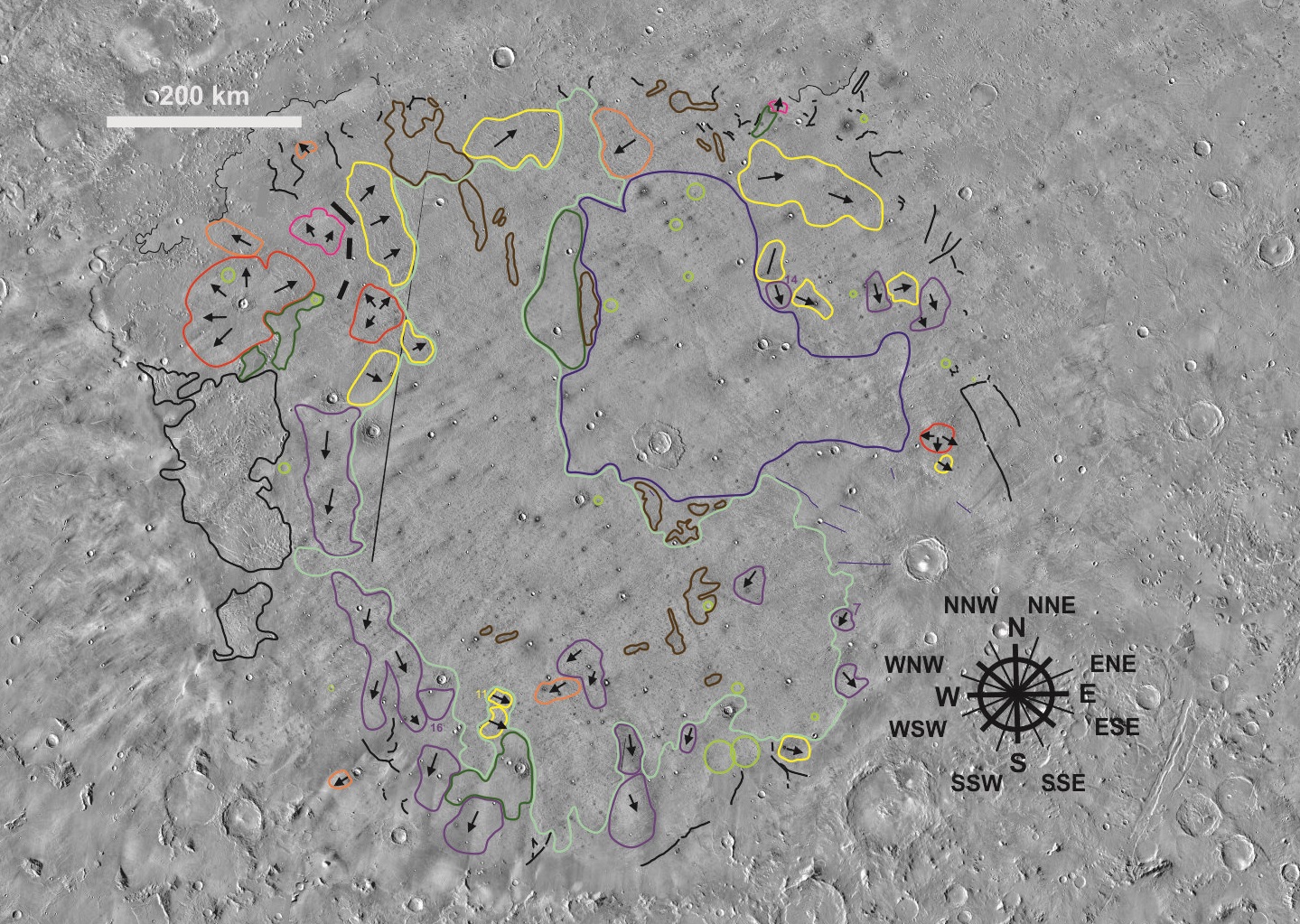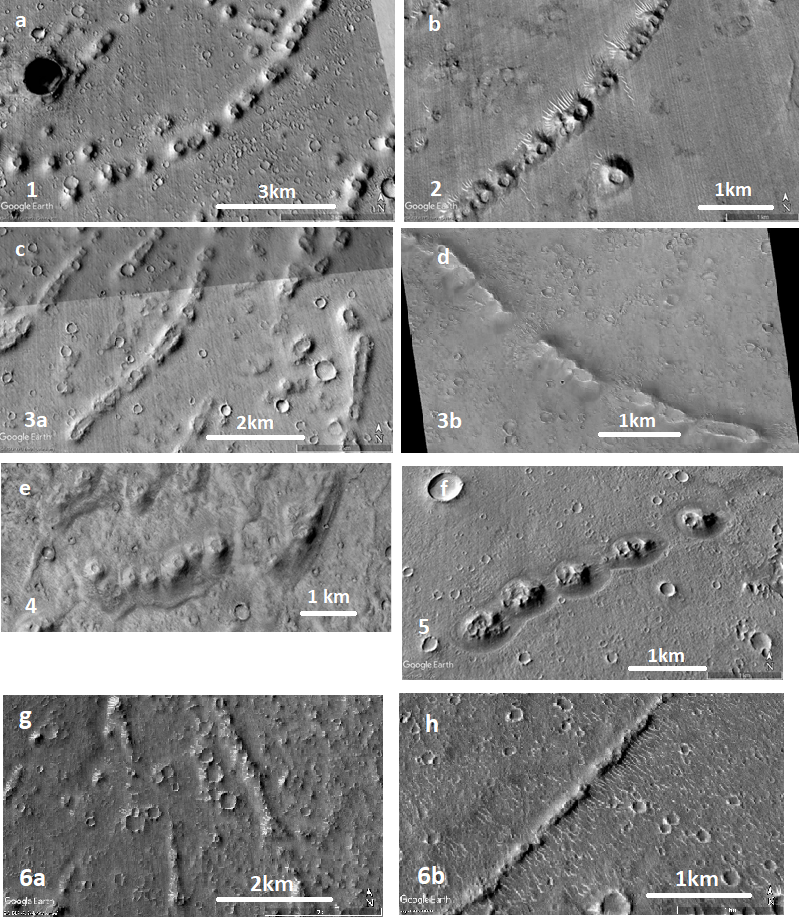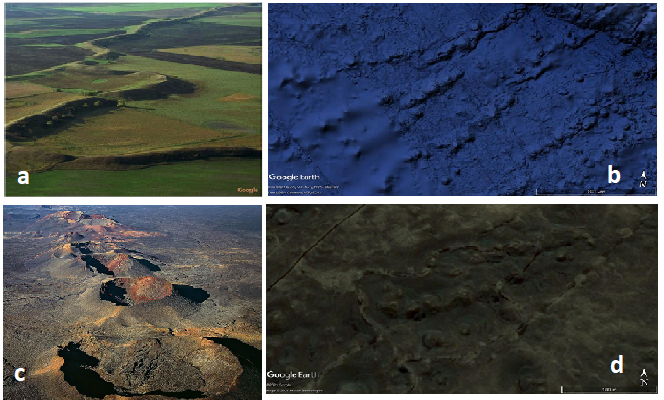Regional and local geological characteristics of Isidis Planitia on Mars and analysis of terrestrial analogues.
- 1Space Research Center PAS, Warsaw, Poland (natalia@cbk.waw.pl)
- 2University of Warsaw, Faculty of Physics, Institute of Geophysics, ul. Pasteura 5, 02-093 Warszawa, Poland, (lczech@op.pl)
- 3Institute of Geological Sciences, PAS, ul. Twarda 51/55, 00-818 Warszawa , POLAND (j.ciazela@twarda.pan.pl)
- 4Wroclaw University of Science and Technology, Wybrzeże Stanisława Wyspiańskiego 27, 50 370 Wrocław, 9, POLAND. (matetuh@gmail.com)
Introduction: There are thousands of small cones on Isidis Planitia on Mars. The cones have diameters of 300–500 m and heights of ~30 m. Many cones form subparallel chains several kilometers in length. Their origin is discussed in many papers [1,2,4,5] however, the mechanism of their formation is not explained, nor the reason for their arrangement in subparallel chains. The cones may be: rootless cones, cinder cones, tuff cones, pingos, mud volcanoes etc. [5]. Some of chains have a characteristic furrow suggesting possibility of fissure volcanism.
The prevalence of these chains indicates that large-scale processes are responsible for their formation. Their proper classification can help identify their origin and explain other large-scale processes on Isidis Planitia. There are a few works about statistics of cones on Isidis Planitia e.g. [1,2,3]. However, we approached the problem in a different way.
Considered region: Our analysis indicates that the cones can be grouped in larger systems. We divided Isidis Planitia into several characteristic regions (Fig.1). There may be several types of cones in one of the distinguished regions. Our division is based on the following structures (Fig. 2):
1. Chains of separate cones,
2. Chains of cones connected with each other,
3a. Chains of cones connected to the furrow through the center,
3b. Chains of cones connected to the furrow through the center with elongated, elliptical cones
4. Chains of cones with the traces of flows,
5. Chains of irregular cones without calderas with a depression around the cones,
6a. Ridge arches without cones,
6b. Chains of cones on the ridges.
In the division of Isidis Planitia shown in Fig. 1, we also paid attention to the orientation of the chains of cones (Fig. 2). The sense of black arrows in regions is explained in Fig. 3 and in the text below. In most of our regions there are also groups of cones that do not form linear chains. Such group are named as "field of cones".
Our current Isidis Planitia division includes 36 regions. We distinguished 11 regions with the predominant arrangement of arcs in the directions between ENE and ESE outlined in yellow (see Fig. 1 for notation of directions), 5 regions with the directions between WNW and WSW outlined in orange, 2 regions with the directions between NNE and NNW outlined in magenta and 15 areas with the directions between SSE and SSW, outlined in purple. 3 regions where the arcs of the cones are concentric (chains have common centers) are outlined in red. These 36 regions cover substantial part of the Isidis Planitia. In the rest of our regions there almost are not chains of cones.

Fig.1. Regional division of the Isidis Planitia (THEMIS background) based the predominant direction of cones chains. Description of the regions in the text.
Except for the regional analyses, we have also mapped sinuous ridges (marked black, winding lines), cracks and serial depressions, occurring near craters (marked blue lines), fields with polygonally cracked surface (outlined in black line), areas with a large number of small craters (outlined in brown ), areas with few or no cones (outline in green) and quasi-circular depressions sQCDs called ghost craters [5] (marked light green circle) (Fig. 1).
In addition, we distinguished a large area without subparallel arcs with chaotic chains (outlined in cyan) and another large area with groups of cones creating fields, not forming chains, (outlined in navy blue).

Fig.2. Various sets of cones in the Isidis Planitia: a) Chains of separate cones, b) Chains of cones connected with each other, c) Chains of cones connected to the furrow through the center, d) Chains of cones connected to the furrow through the center with elongated elliptical cones, e) Chains of cones with the traces of flows, f) Chains of irregular cones without calderas with a depression around the cones, g) Ridge arches without cones, h) Chains of cones on the ridges. The images are mosaic CTX except for d) which is based on HiRISE, ESP_013054_1900.
Analysis of terrestrial analogues: We consider terrestrial analogues, hoping that they will show us possible mechanisms of the formation of cone chains on Mars. We chose such following analogues: glacial eskers [1], cinder cones, submarine volcanoes and rootless cones (Fig.3). Isidis cones are currently studied for the genesis of individual types of cones. We believe that volcanic origin (the result of lava flows) or phreatic origin (cones are form by solid pyroclastic material) are probable. Characteristic furrows in some chains suggest fissure volcanism.

Fig.3. Selected terrestrial analoues of linear structures: a) eskers at Mc Donald Lakes, British Columbia, Canada, b) submarine volcanic cones in the Middle America Trench and the Tehuantepec Transform/Ridge, c) cinder cones on Lanzarote, Timanfaya National Park, www.lowcosttourslanzarote.com/blog/lanzarote-highlights/1-national-park-of-timanfaya, d) rootless cones on in the Landbrot, Iceland.
Conclusions: Our division is made according to consistent characteristic morphological features. The next stage of the work will be to explain the mechanism of the formation of these forms, based on known geological phenomena but in relation to Mars. We want to clarify whether the designated areas were created in the same geological processes, or whether a different mechanism is responsible for the differences in these forms. We suspect that the chains 1, 2, 3a and 3b were created in a similar way but with different intensity of the processes. On the other hand, the chains 6a, 6b and 4 and 5 could have arisen in a different geological process.
References:
[1] Guidat, T., et al., (2015) Earth and Planet. Sci. Let . 411, 253-267. [2] Souček, O., et al., (2015) Earth and Planet. Sci. Let 426, 176-190. [3] Hiesinger H., et al., (2009) 47th Lunar and Planet. Sci. Conf. 2767. [4] Gallinger, C.L. and Ghent, R.R,. (2016) 40th Lunar and Planet. Sci. Conf. 1953. [5] Ghent, R. R., et al., (2012) Icarus 217, 1169-183.
How to cite: Zalewska, N., Czechowski, L., Ciążela, J., and Kuzaj, M.: Regional and local geological characteristics of Isidis Planitia on Mars and analysis of terrestrial analogues., European Planetary Science Congress 2021, online, 13–24 Sep 2021, EPSC2021-446, https://doi.org/10.5194/epsc2021-446, 2021.

